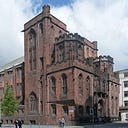Documenting the Birth of Rail Travel
Compiling an annotated bibliography for the Liverpool and Manchester Railway
2030 will see the 200th anniversary of the Liverpool and Manchester Railway, the first ‘inter-city’ railway in the world and in preparation for the upcoming commemorations, the Library is producing an illustrated annotated bibliography of works in its collections related to the railway and its foundation.
Yunqi He, our placement student from the Centre for the History of Science, Technology and Medicine worked on this project from February to April 2023 and writes about her experience here:
As a master’s student in the History of Science, Technology and Medicine, I am thrilled to be part of The Liverpool and Manchester Railway Bibliography project as part of my studies. My longstanding fascination with railways, which often leads me to explore various stations, drew me instantly to this project when I found it listed in the placement plan.
The Liverpool and Manchester Railway (L&MR), which opened in 1830, marks a significant landmark in transportation history. Previously, the journey between Liverpool and Manchester was an arduous affair, with passengers enduring a five-hour carriage ride and freight relying on a two-day canal transit. However, the advent of the L&MR changed all that, as it could complete the route in just two hours — a feat that was unimaginable for horse-drawn transport.
The railway collection is preserved within the Special Collections at the University of Manchester Library, containing approximately 2,600 items across five distinct collections: The General Railway Collection, The Graham Moss Railway Collection, The James I.C. Boyd Railway Collection, The Michael Robbins Railway Collection, and The Kenneth Brown Railway Collection.
My work involves compiling an illustrated, annotated bibliography of works within these collections that document the history and development of the L&MR. This includes assessing published works, maps, charts, illustrations, and ephemera for their historical value, context, and relevance to the narrative of the L&MR’s inception and its engineering achievements.
One aspect of my work that I particularly enjoy is examining maps, which show how railways connected various locales across 19th-century Britain. An 1845 map of England & Wales illustrates this expansion vividly, highlighting the ‘Railway Mania’ period when over 35 lines were established between 1830 and 1845, using the Liverpool and Manchester railway as a global model for railway development.
During my placement, I discovered a letter from the centenary celebration of the Liverpool and Manchester Railway in 1930, addressed to a Mr W.F. Lawrence. After conducting some background research, I discovered that W.F. Lawrence (1844–1935) was the former Member of Parliament for Liverpool Abercromby and the grandson of Charles Lawrence (1776–1853). Charles Lawrence, who had been the Mayor of Liverpool and chairman of the Liverpool and Manchester Railway, played a significant role in the railway’s history. His tenure extended until the railway merged with the London and Birmingham Railway.
The construction challenges faced by Engineer George Stephenson were monumental, particularly at Chat Moss — a notorious four-mile stretch of bog that swallowed the rail tracks. Despite being advised against it, Stephenson undertook the formidable task, constructing 63 bridges across Lancashire’s valleys and stabilizing the bog with layers of woven wooden panels to support the railway tracks. This innovative engineering not only succeeded in ‘floating’ the railway across the bog but also set a precedent for overcoming natural obstacles in railway construction.
Additionally, I also found a 19th-century stranger’s guide to Liverpool and Manchester. It was particularly intriguing, offering a glimpse into the era’s local culture and geography.
This placement has provided me with the invaluable opportunity to interact first-hand with historical materials, creating a tangible link to the past and deepening my connection to Manchester. I am profoundly grateful for the chance to make a meaningful contribution to the Special Collections at the John Rylands Library.
With many thanks to Steven Hartshorne and Aya Van Renterghem for making this experience so rewarding.
Yunqi He — MA History of Science, Technology and Medicine
The University of Manchester digitised Special Collections material is made available via a Creative Commons license (CC BY-NC 4.0) wherever possible. For further information on digital images and to request high resolution copies please contact our Imaging team.

